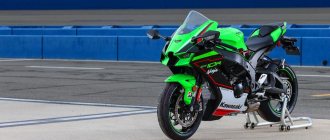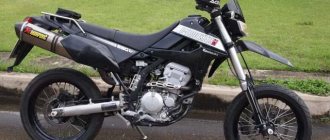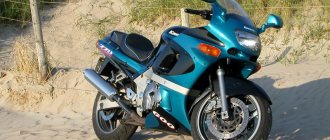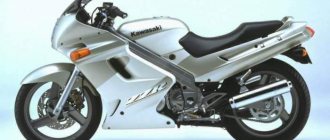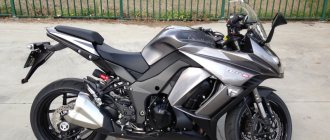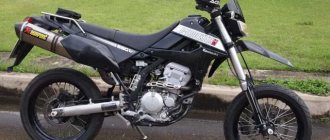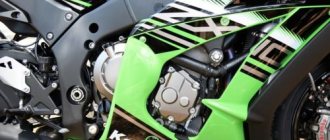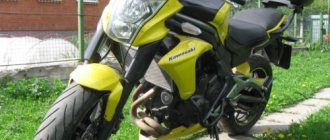Clutch
Despite the fact that its drive is hydraulic, the clutch itself is not very good. We recommend removing the smaller carbon disc, ring disc spring and flat spacer and replacing them with a regular full size disc. Plus, we used three stiffer springs from Pro Circuit.
Clutch modification for Kawasaki KX450 2020
The release force of the stock lever is not enough to fully depress the clutch - when the lever touches the fingers on the grip, the clutch is still in the gray zone. And even when it seems that it is completely squeezed out, it is not so. We talked to the guy who made Eli Tomac's clutch lever and he recommended an ARC PowerLever with a Flip-Chip adjuster installed. It allows you to change the stroke of the lever and select one of six levels, at which it is completely disconnected.
Dimensions and weight
The initial weight of the motorcycle was more than 120 kg. Using global and proprietary solutions, engineers managed to reduce the weight to 106 kg. Dry mass.
After filling the tank full and adding all the necessary liquids, the weight increases by 7 kg . Curb weight - 113 kg .
Dimensions
A cross bike is a rather big thing, but the rider is in contact with it at only 5 points: the footpegs, handles, and sometimes the “fifth” point sits down on the seat. If at least one of these points is not in place, the pilot does not perceive the bike as a whole, no matter how good it is.
Despite the large number of updates, the external dimensions of the motorcycle have not changed. It has:
- length - 2182 mm;
- width - 822 mm;
- in height - 1277 mm.
Wheelbase and ground clearance are 1482 and 328 mm, respectively.
Rear brake
The rear caliper on the giant 250 disc is too sensitive. In order to reduce its grip, we chamfered the rear pads at a gentle angle to smooth out their approach to the disc and reduce the contact area. In addition, we removed the black plastic disc guard from under the swingarm because it interferes with airflow to the disc (Honda also abandoned this element in 2021)
REVIEW – KAWASAKI KLX450R
KAWASAKI first introduced the KLX450R motorcycle in 2008, using the chassis from the already proven motocross KX450F to build it.
The new model was equipped with an updated exhaust and fuel systems, the gearbox was redesigned, an electric starter was added, lighting devices were added, and the chassis was slightly modernized.
The result was a very successful sports device in a more “civilian” modification, which has been produced since then almost unchanged.
In the photo : KAWASAKI KLX450R will go anywhere. And quickly!
Engine KAWASAKI KLX450R
The heart of the KAWASAKI KLX450R is a 449cc, single-cylinder, four-stroke, liquid-cooled engine with a five-speed gearbox, wet clutch, semi-dry sump and forced-pressure lubrication. Power of 56.4 horsepower at 8.5 thousand revolutions - it sounds proud! And quite loud.
When the KAWASAKI KLX450R model appeared, its twin brother KAWASAKI KX450F was equipped with a dual-injector fuel supply system, but in our case, the manufacturer decided to leave the classic option for cross-country equipment - the Keihin FCR-MX40 flat-choke carburetor.
In the photo: the evil genius of motocross - Keihin FCR-MX40 carburetor
Together with a new muffler, a heavier balance shaft, different ignition settings and longer gears in the box, this allowed a change in the torque curve: the former high-revving “torque” engine acquired good thrust at low and medium speeds. KAWASAKI engineers managed to preserve the wild character of the souped-up motocross monster, but made it more flexible and predictable in handling.
Starter KAWASAKI KLX450R
In addition to the new electric starter, the manufacturer also left the option of starting the KAWASAKI KLX450R with a kick starter. The generator in such motorcycles is usually a model of minimalism in order to save weight and may simply not have time to charge the battery, for example, if the motorcycle falls or stalls several times in a row on muddy or sandy sections of the route.
In the photo: general view of the rear suspension of the KAWASAKI KLX450R. The folded kick starter lever is clearly visible on the top right
The kick starter will give you the opportunity to start and get out of even the most difficult situations under your own power, without wasting time on a lap and without waiting for the “technician” or friends.
Suspension KAWASAKI KLX450R
The fully adjustable inverted telescopic fork with brutal 48mm thick legs has 305mm of travel, while the progressive Uni-Trak rear suspension has an even more impressive 315mm. The long-travel suspension is almost impossible to break in any possible conditions, in addition, it also provides an impressive ground clearance of the same 315 millimeters. But such a long-legged KAWASAKI KLX450R also has some consequences - the saddle height of 935 millimeters from the ground may not be suitable for some riders.
In the photo: this is what the links of the KAWASAKI Uni-Trak rear progressive suspension look like
The possibilities for customizing the suspension settings seem almost limitless: 22 stages of compression adjustment and 18 stages of rebound adjustment for the fork; separate adjustment of low- (22 stages) and high-speed compression (more than 2 turns) plus 22 stages of rebound adjustment and adjustable spring preload for the rear shock absorber. It's just some kind of holiday!
In the photo: from outdoor activities to motocross - one good jump!
The suspension settings from the factory are optimal for dirt tracks, paths and small jumps, but with minor changes they are quite suitable for motocross or extremely active recreation on terrain with difficult terrain.
KAWASAKI KLX450R frame
The perimeter aluminum frame gives the chassis the necessary rigidity and weighs noticeably less than its steel counterparts. Its design was battle-tested even before the release of this model and has proven itself very well. And the total weight of the motorcycle is 126 kilograms for such power - a very worthy result.
In the photo: the lightweight and durable KAWASAKI KLX450R frame is a work of technical art
Brakes KAWASAKI KLX450R
The front wheel braking system uses a 250 mm semi-floating petal disc. This design is stronger than all-steel discs and is also less susceptible to thermal deformation. The two-piston front caliper is sufficient for confident braking in any situation. The requirements for the rear brake system are always more modest, so KAWASAKI limited itself to a 240 mm petal disc and a single-piston caliper.
Pictured: KAWASAKI KLX450R front brake system
The shape of both brake discs - front and rear - helps the brake pads self-clean from dirt, which improves the system's performance in difficult conditions.
Features of KAWASAKI KLX450R
The instrument panel includes a clock, speedometer, odometer and trip meter - a necessary and sufficient set for this class of motorcycle. Compact, easy to set up and light in weight, it is also well protected from falls, which are not uncommon in cross-country motorsports.
In the photo: the dashboard is laconic, but includes everything you need
The KAWASAKI KLX450R has a fuel tank capacity of 8 liters, which is slightly larger than the 6.3 liters of the refined motocross KAWASAKI KX450F. Fuel consumption averages 5–6 liters per 100 kilometers, but highly depends on driving style and the nature of the terrain.
This model, unlike dual-purpose enduros, for example, such as the KAWASAKI KLR650-E, does not provide for the installation of luggage cases and other travel equipment and is, in fact, a purely sports equipment with all the ensuing consequences: light weight, minimal maintenance intervals and the unbridled power of the rear wheel tearing up the ground.
Fuel cards
A recent Kawasaki innovation for quickly switching fuel maps is something called plugs. These are connectors of different colors with jumpers installed on them, which allow you to select one of the fuel maps sewn into the ECU. The maps themselves, of course, are edited, but not using jumpers on the connectors, but using a special device - Kawasaki FI Calibration Tool.
The stock green plug selects the most convenient card. It is significantly more powerful than the soft black plug and much less hyperactive than the aggressive white plug. The black card loses 1 to 2 horses to the green card, and the white card gives out exactly the same amount as the green card, only more sharply.
Modifications
Since 2008, 2 more versions have appeared in the concern’s line, assembled on the basis of the older model.
- Kawasaki KLX450R — a motorcycle for hard enduro. An electrical circuit has been added to power the headlight and operate the electric starter. The engine is a little stifled in the upper speed range. The suspension has been strengthened and redesigned. Instead of an injector there is a carburetor .
The enduro version is visually distinguished by the presence of an original headlight shape.
- Kawasaki KX450F 53 hp - in its main features it completely repeats the basic version. Engine strangled - 53 mares .
Flaws
Like any equipment that appeared on the market not yesterday, the motorcycle revealed a number of disadvantages.
- General ergonomics of landing . No problems are observed on other models of similar engine volume.
- Handling - the powerful engine does not allow you to take sharp turns normally.
- Swing - by installing a rear swingarm of increased length, the developers managed to solve the problem with the rear, but a problem arose at the front. Experts recommend slightly raising the fork legs in the yokes. If you have the finances, it is recommended to completely replace the original traverse with a tuned one.
The chain deserves a separate discussion. On this model, due to the powerful and evil engine, the chain is a consumable item . You need to check and tighten it before every trip. There were situations when the chain simply broke.
The chain tensioner roller has a toothed pulley.
and dignity
The main and main advantage of the motorcycle is its engine.
There are also mixed opinions about the suspension. In most cases, they are positive, but there are wishes to make its setting not stepwise, but smooth, like other bikes of the concern.
